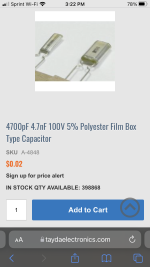jwyles90
Well-known member
Hey all,
Apologies if this is a silly question, tried searching the forum for answers but couldn’t find much. I got an order from Tayda the other day and I ordered some of those 4n7 caps not realizing they were any different. I’ve never really seen anything like them before, so I’m just curious if they function the same as any other box cap, or if they have some specific purpose or use that I’m not aware of.
As far as I can see they just say lead free on the description, so I’m also curious if that has any impact on their performance in a circuit.
Apologies if this is a silly question, tried searching the forum for answers but couldn’t find much. I got an order from Tayda the other day and I ordered some of those 4n7 caps not realizing they were any different. I’ve never really seen anything like them before, so I’m just curious if they function the same as any other box cap, or if they have some specific purpose or use that I’m not aware of.
As far as I can see they just say lead free on the description, so I’m also curious if that has any impact on their performance in a circuit.


